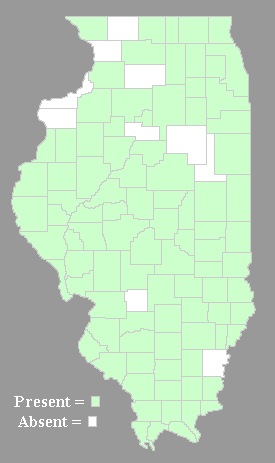Description: This plant is a summer annual that becomes 2-5' tall, branching occasionally. The round stems are glabrous and succulent, pale green to pale reddish green, and somewhat translucent. They are rather fragile and break easily. The alternate leaves are up to 5" long and 2½" across, although they are usually about half this size. The leaves are ovate, thin-textured, and hairless. There are low broad teeth along their margins. While the stems are often shiny, the leaves have a dull upper surface. The slender petioles are up to 2" long and usually shorter than the blades of the leaves.

From the axils of
the upper leaves, there occurs small clusters of 1-3 orange flowers.
These flowers are held horizontally on drooping pedicels. Each flower
is about 1" long and has a conical shape with upper and lower lips.
There are 3 sepals and 5 petals (although this is difficult to
discern). Two lateral sepals are small and membrananous; they are light
green to light yellow and are located behind the upper lip. The third
sepal forms the conical posterior of the flower, including the small
nectar spur. This portion of the flower is typically light orange and
shiny; the nectar spur usually bends forward to a position underneath
the rest of the flower. The petals form the front of the flower and are
usually dark orange with reddish streaks or brown dots. One petal forms
the upper lip, which is curved upward, while 2 fused petals form the
lower lip. The lower lip often is divided into 2 lobes and functions as
a landing pad for visiting insects. There are also 2 smaller lateral
petals between the upper and lower lips of the flower. A cluster of
stamens with white anthers lies underneath the ovary near the upper
lip. The blooming period occurs from mid-summer to early fall, and
lasts about 2 months. There is no floral scent. During the fall,
insignificant cleistogamous flowers form seed capsules with fertile
seeds without any need for cross-pollination. These oblong seed
capsules are divided into 5 sections, which split apart, flinging the
large seeds a considerable distance. The root system consists of a
shallow branching taproot. This plant often forms colonies by reseeding
itself.

Cultivation:
The preference is light shade to partial sun, wet to moist conditions,
and a fertile soil with an abundance of organic material. Submergence
of the roots by flood water is tolerated for up to 2 weeks without
apparent ill-effects. Sometimes the leaves are affected by mildew late
in the year. It is easy to start this plant from seed.
Range & Habitat:
The native Orange Jewelweed is a common plant that occurs in most
counties of
Illinois; it is less common in the NW area of the state. Habitats
include openings in moist woodlands, partially or lightly shaded
floodplains along rivers, edges of woodland paths, swamps, seeps and
fens, and roadside ditches. This species tolerates disturbance better
than most wetland plants.
Faunal Associations:
The flowers attract the Ruby-Throated Hummingbird and long-tongued
bees, including bumblebees and honeybees. Swallowtail butterflies are
less common visitors. These visitors seek nectar; many long-tongued
bees also collect pollen. Sometimes bumblebees will steal nectar by
chewing holes near the spur of the flower. Various smaller insects
(e.g., Syrphid flies) will visit the same holes to steal nectar. The
caterpillars of several moths feed on the foliage, including Euchlaena
obtusaria (Obtuse Euchlaena), Spilosoma latipennis
(Pink-Legged Tiger Moth), Trichodezia albovittata
(White-Striped Black), and Xanthorhoe lacustrata
(Toothed Brown Carpet). Upland gamebirds eat the large seeds, including
the Ruffed Grouse, Ring-Necked Pheasant, Greater Prairie Chicken, and
Bobwhite Quail. Among mammals, White-Tailed Deer browse on the foliage,
while the White-Footed Mouse eats the seeds.
Photographic Location:
A partially shaded roadside ditch along a woods near Urbana, Illinois.
Comments:
The attractive orange flowers glisten in the sunlight, hence the name
'Jewelweed.' The other Jewelweed in this genus is Impatiens
pallida (Yellow Jewelweed). The latter has similar foliage,
but its flowers are pale yellow. The Jewelweeds have a muciliginous sap
that is supposed to soothe skin irritation caused by Poison Ivy and
Stinging Nettle. This sap also has fungicidal properties and has been
used to treat Athlete's Foot. The cultivated Impatiens of the
horticultural industry have been introduced from such areas as East
Africa and New Guinea. They rarely escape from cultivation and are not
considered a significant threat to native habitats.